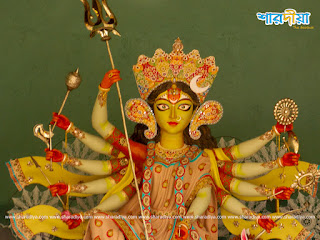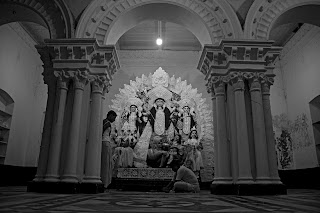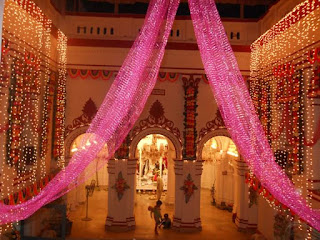Thursday, 30 December 2021
Sunday, 29 November 2020
Durga Puja 2020
Durga means impassable, invincible, and unassailable - the one who can fight against evil and protects the universe from negativity. She appears in various forms as an independent deity in the pages of ancient history. Another name for Maa Durga is Durgatinashini which resembles- ' the one who eliminates suffering'.
When the world was helpless and unable to demolish the evil demon Mahishasura, the Trinity of Brahma, Vishnu and Shiva created a powerful female incarnation called Goddess Durga.
Durga emerged from the holy water of Ganga as a psyche when all the good and goddess from her into a physical form with ten hands - as the most powerful to defeat the demon.
Maa Durga's face was structured by Lord Shiva, while her torso was crafted by Indra. Her breasts and teeth were made by Chandra and Bramha respectively. The most unique part of Maa Durga is her eyes which were crafted by Agni. She was a supreme power where every god and goddess created with their powers. She was born as Mahamaya - the Great Mother of the Universe who will protect everyone from the destruction of civil forces in the universe.
After acquiring her physical form, every god and goddess gifted her their blessings in the form of weapons. The ten hands of Goddess Durga holds:
Conch - symbolizing the antediluvian sound from where the entire creation is formed.
Sudarshan Chakra - symbolizes that since Durga is the creation of all gods, so all the universe revolves around her.
Lotus - represents wisdom and knowledge
Sword - Mark of sharpness and overcome their negativity.
Bow and Arrow - a symbol of energy and strength
Trishul - it has three qualities of Tamas, Rajas and Sattva.
Mace - enjoins to exhibit loyalty, love and devotion of Maa Durga
Vajra - symbolizes firmness, determination and supreme power
Axe - the power to destroy and create
Snake - indicates the upward movement from the lower state of consciousness to the high state of existence.
Incarnations of Durga
There are nine incarnations of Maa Durga including Kali, Bhagvati, Bhavani, Ambika, Lalita, Gauri, Kandalini, Java, Meenakshi and Kamakshi.
Eyes of Maa Durga -
Maa Durga is also called as Triyambake, resembling the three-eyed Goddess. The left eye represents desire, peace and calmness of the moon. While the right eye represents the power of the sun; and the middle or central eye replicates the ability to burn with its power of fire.
Top 20 Durga Puja of Year 2020
Monday, 23 November 2020
RANI RASHMONI HOUSE - JANBAZAR
RANI RASHMONI HOUSE
- JANBAZAR
The festival of Durga Puja at Kolkata appears to be a remarkable tradition. Durga puja as used to commemorate by the aristocrat families and Zamindars of ancient Calcutta relates the history and foundation of Kolkata. In this post, tried to show a glimpse of the century old Durga Puja celebrations of the aristocrat and Zamindar families of Kolkata.
Thursday, 19 November 2020
Friday, 2 October 2020
Hatkhola Dutta Bari Old Durga Puja Since 1716
Wednesday, 30 September 2020
সরকার ভিলা দুর্গোৎসব
পুজো আসলেই বন্ধুবান্ধবদের মধ্যে আলোচনা শুরু হয় এবার পুজোয় কার কি প্ল্যান ? কেউ বলে সারারাত ঠাকুর দেখতে যাব , কেউ বলে ঘুরতে যাবো কলকাতার বাইরে । আর আমায় কেউ বললে আমি হেসে শুধু বলি আমার বাড়িতে পুজো হয়। ব্যাস তখন সবাই স্বীকার করে নেয় বাড়ির পুজোর কাছে বাকি সব আনন্দ কিছুই না। আসলে বাড়ির পুজোর যে কি মজা , লিখে প্রকাশ করা যায় না। তাই প্রতি বছর পুজোর আনন্দের কথা উঠলে আমার শুধু আমাদের বাড়ির পুজোর কথা মনে আসে ।

























































